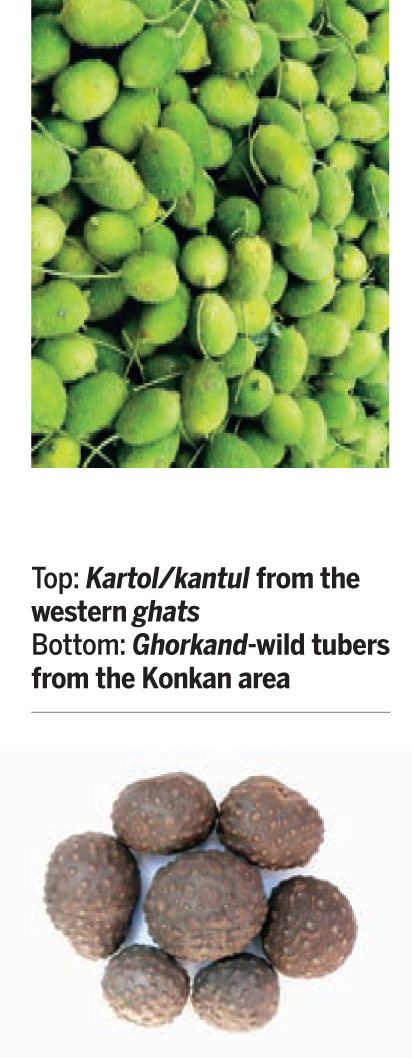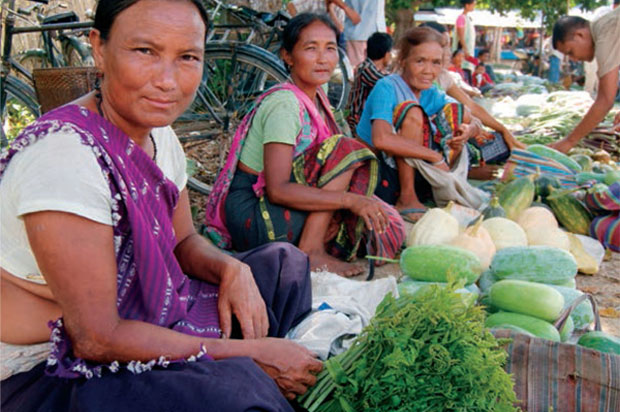
The Konkan countryside is warm and dusty with the cloying fragrance of flowering mango trees. Amidst this is the exciting atmosphere of a weekly bazaar in the village. One sees farmers and women squatting on jute sacks peddling their farm produce. As I drive past these villages, I make it a point to stop by and purchase local varieties of rice. Sometimes just after the rainy season, the bazaars at Raigad, Konkan and Panvel offer exciting varieties of yams and tubers that grow underground or vegetables like kartul collected by the tribals in the forests.
A veritable feast for the eyes and the palate. Against this background, I think more and more urban citizens seem to be losing touch with the seasonal offers of nature and that our food plate is becoming narrower in its choices.
The year 2014 has been declared as the International Year of Family Farming. It has triggered a pertinent question: How does India fit into this celebration? Nearly 60% or more of India’s economy is agriculture oriented. Farming here is mostly made up of medium, small scale and marginal farms. Many farmers barely scrape through, while others are in debt deep enough to cause them to take their own life. It seems we are at a crossroads between redeeming our family run farms and simultaneously evaluating the mistakes of large- scale farms, something farmers in the West have already realized. Hence, we need to go a bit deeper into the real essence of sustainability in farming.
A number of large-scale farmers in Europe are so squeezed by the supermarket chains that they are selling out their debt ridden or unprofitable greenhouses or farms and are moving to smaller scales of economy. They are striving to sell directly to local retail and at weekly farmers’ markets.
Supplying to supermarket chains that have tremendous clout and power has become a non-viable option for many and at the same time knocks their self-esteem as farmers and humans.
Additionally, the supermarkets define what variety, forms and quality of produce the farmers should deliver. Thus, tons of vegetables that are good to eat but slightly disfigured or smaller in size have to be thrown into rubbish heaps. This is a colossal waste at a time when climate change is already extracting its dues. With this in view, India should directly get into the post-modern but sustainable farm module rather than repeat the mistakes the West has made.
Sustainability is an oft-repeated mantra in the corporate world for image building. But it is irrelevant for the urban consumer and the farmer if it has no intrinsic value. One current development is a major push from India’s former agriculture minister to modernize agriculture and bring in foreign investors and contract farming for specific value addition to agriculture (which I think actually means ‘processing of food’). This may bring in a lot of foreign entities, whereby Indian land, water and resources will be used to produce and process food for the small luxury sector in India or for export.
In this scenario, nearly 70% of our population may further be deprived of nutritious food. Case in point is that of the grain Quinoa. The moment it became known as a ‘power/super food’ in the European and US retail sectors, it was exported to the point that the locals (in the Andes, Peru and Bolivia), whose dietary nutrition depended on it, could not afford to buy it. Also, vast tracts of cerrados (Brazilian savannahs) are being destroyed to cultivate soya beans, which are exported and a chunk of the produce is intended for cattle feed.
UNCTAD (United Nations Conference on Trade and Development) and UNEP (United Nations Environment Programme) reported in their studies covering 2 million hectares and 1.9 million farmers in Africa, that organic and sustainable farming gave, on an average, a higher percentage crop yield per acre.
Going back to the Brazilian savannahs, the small farmers that cultivated formerly barren lands, with no pesticides, less fertilizers and had a broad-based biodiversity of crops, could not only increase their income and feed the rural areas but also develop lush landscapes and in the process control pests. This underlines the fact that sustainable community managed farms are the road ahead to food security and to provide a broad base of nutritional essentials. Also, if we tie in a parallel movement of consumer awareness, much can be achieved.
We have quite a few excellent Community Supported Agriculture (CSA) examples around us. Ashwin Paranjpe of Gorus (a farmer’s collective) in Pune comes from a family that has been into environment, water and rural/urban social issues. During his Masters in Horticulture in the US, he was greatly influenced by the community-based farming with direct marketing concepts practiced in Florida. His foray in Spain as an experimental agriculturist, on a neglected piece of land, gave him added experience and motivation. On returning to Pune, he worked in the Kolvan Valley motivating farmers to form groups towards a common goal and guided them with his training, experience and ideas to enable market access directly in Pune.
Now Gorus supplies the farmers’ produce to 200 families in this city. The range of products is growing. Paranjpe has also been successful in initiating a revival of Emmer wheat (locally called Khapali gahu), which has a low gluten and glycemic index (ideal for diabetics) and is one of the original wheat plants. This is a good example to be emulated. It will benefit farmers and motivate them to produce organic, diverse farm produce, give them the much-needed profits which the middle men squeeze out of them and at the same time ensure fresh, healthy food for urbanites. If this doesn’t happen, we will see more migration to cities, while fertile land lies fallow with no one to tend it. Definitely not a sustainable solution where food security is concerned.
A group of students formed Organic Campus, which was an offshoot of the Groenteclub initially set up by women in the city of Bussum, Netherlands. It was initiated for procuring organic vegetables, fruits, meat and cheese, directly from a group of farmers in the vicinity.

It has grown into a larger concept reaching more citizens. Other initiatives have taken place in Amsterdam and the US, where urban groups formed their own cooperatives. They bought directly from farmers locally. It also entailed a commitment that each person buying the produce should also volunteer some time to work in the cooperative for it to operate at minimum costs.
We are aware that in the lives we lead, time may be short but if we pool our free time, our intellectual resources and our experiences from our professional sphere we may be able to help NGOs working in rural areas to achieve their goals. Sustainability thus also becomes a commitment from each one of us. With a group of like-minded friends, it could also be fun. The philosophy behind these initiatives is that you become a cog in the community, that each one becomes a participant and not a passive consumer.
Global challenges, the encroachment of global businesses into our private spheres, namely the threat of bio-diverse nutrition and in the case of farmers, fears of being pushed into oblivion or converted into laborer’s in a corporate farming world, are very real.
Many individual small-scale initiatives are creating a new paradigm shift across the world by connecting farmers to urban populations. We hope the International Year of the Family Farm will be an inspiration for all of us to connect to farmers directly.
Sumitra Naren is active as a consultant in the organic food sector and related sustainable technologies. She works in both the EU and India as director of SNConsultancy.



Comments (0)